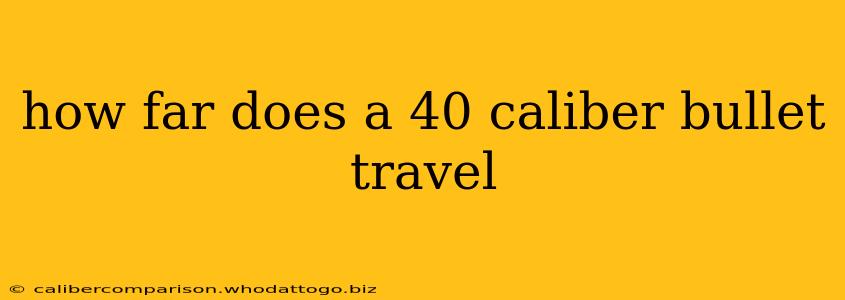The question "How far does a .40 caliber bullet travel?" doesn't have a simple answer. The distance a .40 caliber bullet travels depends on several crucial factors, making a precise figure impossible without specifying these variables. This article will explore these factors and provide a detailed understanding of the effective range and maximum range of a .40 caliber round.
Factors Affecting .40 Caliber Bullet Travel Distance
Several elements significantly influence how far a .40 caliber bullet will fly:
-
Muzzle Velocity: The speed at which the bullet leaves the gun's barrel is paramount. Higher muzzle velocity translates to a longer range. Different .40 caliber cartridges and firearms will produce varying muzzle velocities.
-
Bullet Weight: Heavier bullets generally have lower muzzle velocities but retain energy better over distance, potentially extending their effective range. Lighter bullets, while faster initially, lose energy more quickly.
-
Ballistics Coefficient (BC): This measures a bullet's ability to overcome air resistance. A higher BC means the bullet will retain velocity and travel further. The shape and design of the bullet significantly impact its BC.
-
Barrel Length: A longer barrel allows more complete burning of the propellant, resulting in a higher muzzle velocity and increased range.
-
Altitude and Air Density: Higher altitudes have thinner air, reducing air resistance and potentially increasing range. Similarly, colder, denser air will slow the bullet down more than warmer, less dense air.
-
Angle of Fire: Shooting at an angle, rather than horizontally, will affect the trajectory and range. A higher angle initially increases range, but the bullet will eventually fall back to earth.
-
Wind: Wind conditions significantly impact accuracy and range. Headwinds decrease range, while tailwinds increase it. Crosswinds affect bullet trajectory and accuracy.
Effective Range vs. Maximum Range
It's crucial to differentiate between effective range and maximum range:
-
Effective Range: This is the distance at which a shooter can reliably hit a target with sufficient accuracy and stopping power. For a .40 caliber, the effective range is generally considered to be around 50-75 yards (45-68 meters). Beyond this, accuracy and lethality significantly decrease.
-
Maximum Range: This refers to the theoretical maximum distance a bullet can travel before hitting the ground. This can be several hundred yards, depending on the factors mentioned above. However, the bullet's velocity and energy will be severely diminished at this distance, making it largely ineffective.
.40 Caliber Bullet Trajectory: A Complex Equation
Predicting the precise trajectory of a .40 caliber bullet requires complex ballistic calculations considering all the variables discussed. Ballistic calculators and software are available for this purpose, taking into account factors like bullet type, firearm specifics, and environmental conditions.
Conclusion: Understanding the Limitations
While a .40 caliber bullet can travel a considerable distance, its effective range is significantly shorter. Understanding the limitations of the cartridge and the various factors affecting its trajectory is crucial for safe and responsible firearm handling. Always practice safe gun handling, follow relevant laws and regulations, and remember that beyond the effective range, the bullet becomes unpredictable and potentially dangerous. Consult expert resources and training for accurate information and safe firearm practices.

